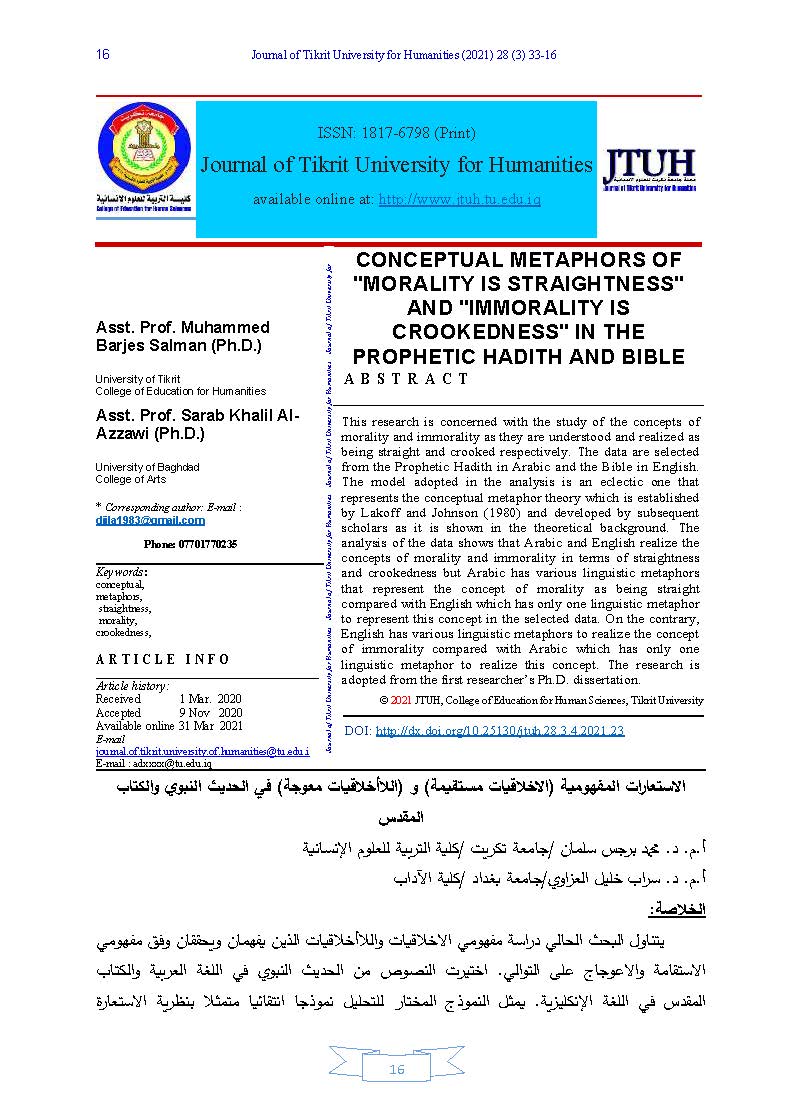CONCEPTUAL METAPHORS OF "MORALITY IS STRAIGHTNESS" AND "IMMORALITY IS CROOKEDNESS" IN THE PROPHETIC HADITH AND BIBLE
Main Article Content
Abstract
This research is concerned with the study of the concepts of morality and immorality as they are understood and realized as being straight and crooked respectively. The data are selected from the Prophetic Hadith in Arabic and the Bible in English. The model adopted in the analysis is an eclectic one that represents the conceptual metaphor theory which is established by Lakoff and Johnson (1980) and developed by subsequent scholars as it is shown in the theoretical background. The analysis of the data shows that Arabic and English realize the concepts of morality and immorality in terms of straightness and crookedness but Arabic has various linguistic metaphors that represent the concept of morality as being straight compared with English which has only one linguistic metaphor to represent this concept in the selected data. On the contrary, English has various linguistic metaphors to realize the concept of immorality compared with Arabic which has only one linguistic metaphor to realize this concept. The research is adopted from the first researcher’s Ph.D. dissertation.
Metrics
Article Details

This work is licensed under a Creative Commons Attribution 4.0 International License.
College of Education for Humanities, TIKRIT UNIVERSITY. THIS IS AN OPEN ACCESS ARTICLE UNDER THE CC BY LICENSE http://creativecommons.org/licenses/by/4.0/
References
Al-Bukhāri, M. I. (d256AH) (2007). Šaĥīh ul-Bukhāri. Translated into English by: Al-Sharif, M. M. Beirut: Dar Al-Kotob Al-Ilmiyah.
An-Naisābūri, Muslim (d261AH) (2012). Šaĥīĥ Muslim. Beirut: Dar Al-Kotob Al-Ilmiyah.
An-Nawawi, Y. (2004). Riyadh uš-Šaliheen min Kalami Saiyd il-Mursaleen. Cairo: Maktabat uš-Šafa.
At-Tabrīzi, M. A. (2002). Mishkāt ul-Mašābīĥ. Translated into English by: Al-Sharif, M. M. Beirut: Dar Al-Kotob Al-Ilmiyah.
Clarke, Adam (1832). The Adam Clarke Commentary. Retrieved from: http://www.studylight.org/commentaries/acc/
Coffman, James (1999). Commentaries on the Old and New Testaments. Retrieved from: http://www.studylight.org/commentaries/bcc
Coke, Thomas (1803). Commentary on the Holy Bible. Retrieved from: http://www.studylight.org/commentaries/tcc/
Deignan, Alice (2005). Metaphor and Corpus Linguistics. Amsterdam: John Benjamin's Publishing Company.
Geeraerts, Dirk (2010). Theories of Lexical Semantics. Oxford: Oxford University Press.
Gill, John (1999). The New John Gill Exposition of the Entire Bible. Retrieved from: http://www.studylight.org/commentaries/geb/
Johnson, Mark (1987). The Body in the Mind: The Bodily Basis of Meaning, Imagination, and Reason. Chicago: The University of Chicago Press.
Kövecses, Zoltan (2002). Metaphor: A Practical Introduction. Oxford: Oxford University Press.
Kretzmann, Paul (1923). Popular Commentary of the Bible. Retrieved from: http://www.studylight.org/commentaries/kpc
Lakoff, George and Johnson, Mark (1980a) Metaphors We Live By. Chicago: The University of Chicago Press.
Lakoff, George and Johnson, Mark (2003) Metaphors We Live By with a New Afterward. Chicago: The University of Chicago Press.
Lakoff, George ; Espenson, J. and Schwartz, A. (1991). Master Metaphor List. California: Cognitive Linguistics Group.
Merriam-Webster's Collegiate Dictionary (11th Edition). (2004). Massachusetts: Merriam-Webster, Incorporated.
Oxford: Advanced Learner's Dictionary of Current English. (2000). Hornby A. S. (6th Edition). Edited by: Sally Wehmeier. Oxford: Oxford University Press.
Pragglejaz Group (2007). "MIP: A Method for Identifying Metaphorically Used Words in Discourse" in Metaphor and Symbol (vol22). Amsterdam: Lawrence Erlbaum Association, Inc. p.p. 1-39.
SOED The Shorter Oxford English Dictionary (2002). Oxford: Oxford University Press. (CD-ROM, version 2.00).
Stockwell, Peter (2002). Cognitive Poetics: An Introduction. London: Routledge.
Ungerer, Friedrich and Schmid, H. (2006). An Introduction to Cognitive Linguistics. London: Longman.




